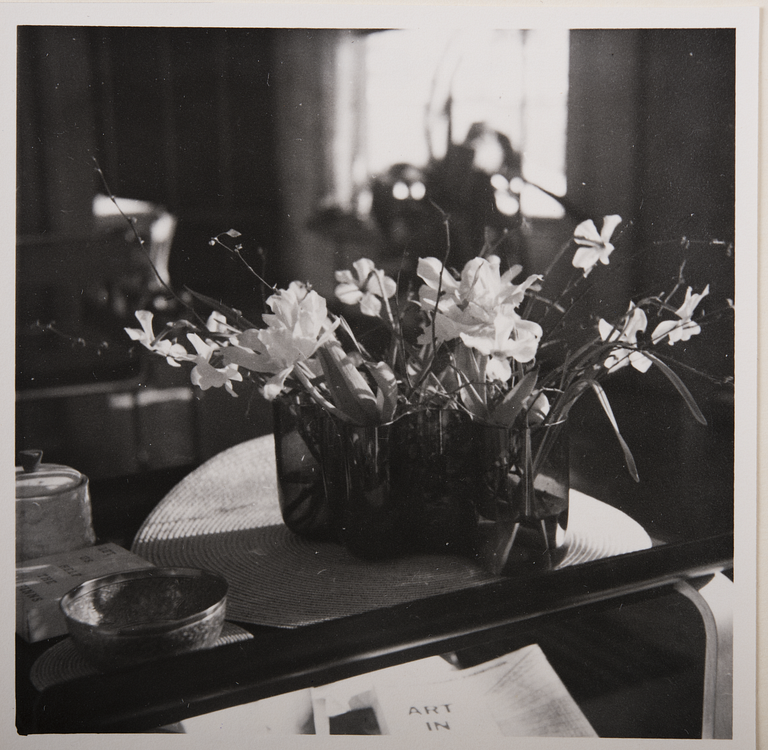Alvar Aalto
Alvar Aalto, A '9749' vase signed A. Aalto -37 Karhula.
Green glass is blown into a wooden mould. Height 13.5 cm.
Wear due to age and use. Insignificant chip. Marks due to the manufacturing process and bubbles. Scratches.
Provenance
Alvar Aalto, thence by descent in the family.
The furniture, lamps, and vases for sale are from the home of our parents Johanna and Yrjö Alanen. My mother, who was the daughter of Aino and Alvar Aalto, presumably brought some of the furniture with her when she got married and moved out of her childhood home in 1952.
The old chests of drawers were my parents' bedside tables throughout their lives. They were originally designed by Aino Aalto for the Helsinki Minimum Apartment Exhibition in 1930. I also remember that the cabinet designed in the 1940s was always part of their interior design. The two vases for sale are from the Aalto home on Riihitie and are part of Alvar Aalto's collection.
Aino and Alvar Aalto met Danish designer Poul Henningsen in Copenhagen in 1928 and became good friends. Henningsen's ceiling lights were chosen for the interior of the Lounais-Suomen Maalaistentalo (Southwest Finland Landbo House), which was completed the same year. The Aaltos also got a red ceiling lamp designed by Henningsen for their newly built apartment in the Maalaistentalo building. Aino Aalto described the PH lamps in an article about the Aalto residence in The Architect magazine published in 1929.
When the Aalto family moved in 1936 to their new home at Riihitie 20 in Helsinki, the red PH lamp was placed above the dining table. The red PH-light can be seen in the attached photograph taken by Aino during a family breakfast in 1941.
Heikki Aalto-Alanen (free translation)
Exhibitions
Architect Alvar Aalto found his way into glass design in the 1930s by participating in several design competitions in the field. Perhaps the most important victory can be the art glass competition announced by the Karhula Glassworks factory in 1936, which resulted in one of Finland's best-known and most beloved vases.
In 1936, Alvar Aalto had been chosen to design the Finnish Pavilion in Paris for the following year's World's Fair. Shortly afterward, the Karhula Glassworks factory organized a design competition with a focus on glass objects. These objects were to be exhibited in Paris and Aalto won the design competition yet again. His work presented in the competition was called ‘Eskimoerindens skinnbuxa’. Aalto had sketched several different vases with curved lines some of which were seen at the Paris World's Fair. Aalto had placed the vases of different heights on an exhibition table covered with gravel, a picture of this can be found in the magazine The Architect 9/1937.
In the pre-war years, only small quantities of the various vase models that originated from the competition were manufactured. The curving lines and asymmetrical shapes, typical for Aalto were judged to be too bold and experimental and did not appeal to the general public. The design also posed technical manufacturing challenges - they were originally manufactured by using a wood mold until the 1950s. Using this technique, consequently made the surface uneven and lively. This simultaneously limited the quantity of production.
Post-wars, the production of Aalto vases gradually resumed, and in the following decades, due to the changes in manufacturing techniques, vases could be produced in much larger quantities. At the same time, public interest began to focus on Iittala's model 3030, made in a metal mold, which later took its place as the familiar Savoy vase.
More information
Pictures Aalto Family Collection and The Architect magazine 9/1937.
Designer
Alvar Aalto is one of Finland's most prominent architects and designers and one of Scandinavia's biggest proponents of modern architecture and design. Several of the furniture and vases he designed are today considered iconic design classics, including the Savoy vases, the Beehive lamp, and Armchair, model '31'.Alvar Aalto is the most internationally famous Finnish architect and designer. Aalto was a great ambassador for Finnish design at a time when the Finnish people were thinking about how to present themselves to the rest of the world. He gave equal weight to form and function, and was inspired by the Finnish landscape. Aalto is one of the most important representatives of modern architecture and has created its own architecture direction, whose aesthetic effect is based on careful planning of the buildings in relation to the environment, a human dimension and good sense of material.
Read more

















































